Items
Subject is exactly
Neighborhoods
-
 2021-11-30
2021-11-30Project Hospitality on the Frontlines of Covid
This video was put together by our development department. It showcases the work Project Hospitality has done during the pandemic. -
2020-05-02
Social distancing
This photo is taken from the CSI Public History Coronavirus Chronicle Facebook page. (May 2, 2020, author unknown) I look at this photo and remember when social distancing was still fresh and new and everyone did it. Now, it feels like people are starting to lose that boundary of personal space and wanting to stand as close as they can behind you in a check out line. I remember actually enjoying the distance people were forced to take, and a part of me wishes social distancing was still in effect. -
 April 8, 2020
April 8, 2020COVID Litter
What you will find as you take a walk down any block, street, avenue, or boulevard on Staten Island. -
 April 2020
April 2020Cin 211
the daily life of Matthew Torres during the height of the pandemic -
 2020-04-06
2020-04-06The New Plague
Life in Self-isolation, "Love in the Time of COVID-19" Project, CIN 211 College of Staten Island -
 2020-06-17
2020-06-17The New NormalS F
Love in the Time of Covid-19. A great video by Shania Fagan, titled The New Normal. Will our lives go back to normal anytime soon? -
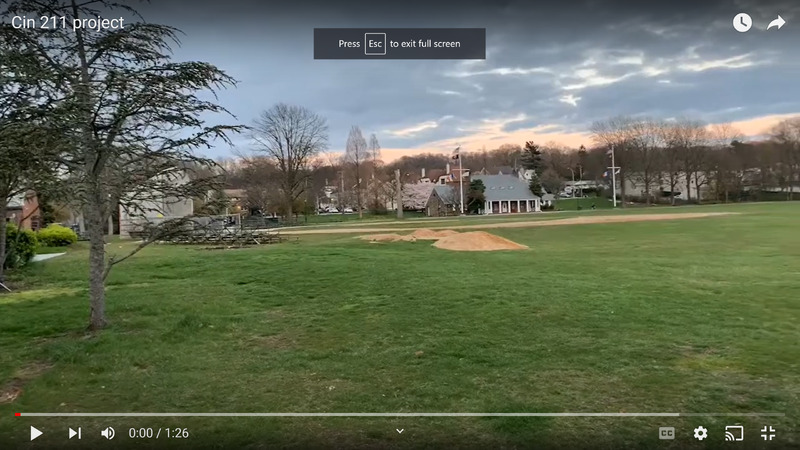 April 5, 2020
April 5, 2020Cin 211 project
a look at the pandemic through the eyes of youtuber @user-hm9gs8by5i -
 April 5, 2020
April 5, 2020Rheana Galloway project2
a look at the early stages of the pandemic through the eyes of Rheana Galloway. -
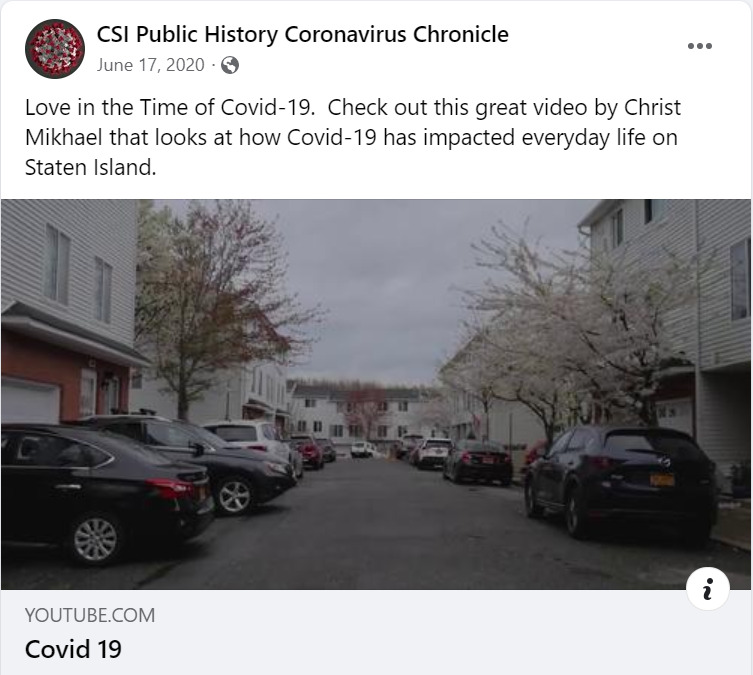 2020-06-17
2020-06-17Covid-19
Love in the Time of Covid-19. Check out this great video by Christ Mikhael that looks at how Covid-19 has impacted everyday life on Staten Island. -
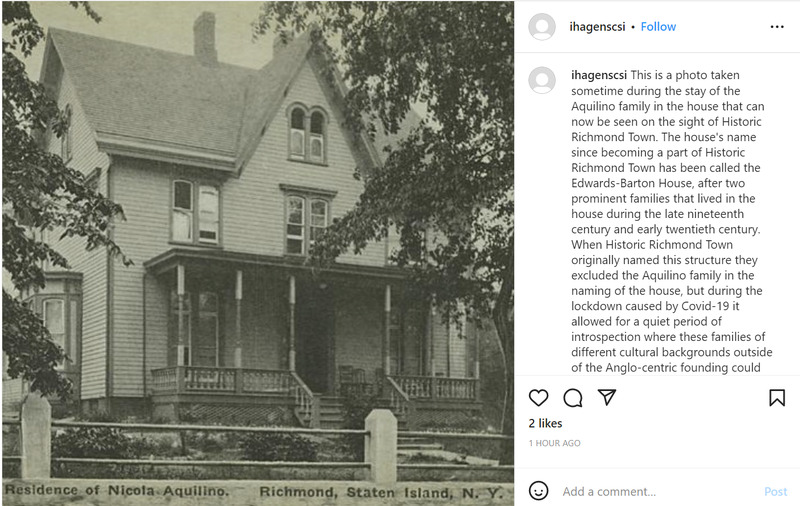 2023-02-28
2023-02-28Aquilino House
This is a photo taken sometime during the stay of the Aquilino family in the house that can now be seen on the sight of Historic Richmond Town. The house's name since becoming a part of Historic Richmond Town has been called the Edwards-Barton House, after two prominent families that lived in the house during the late nineteenth century and early twentieth century. When Historic Richmond Town originally named this structure they excluded the Aquilino family in the naming of the house, but during the lockdown caused by Covid-19 it allowed for a quiet period of introspection where these families of different cultural backgrounds outside of the Anglo-centric founding could be honored. Staten Island is a very diverse place and the institutions that operate on its soil should reflect that aspect. Photo credit goes to New York Public Library. -
 2020-12-22
2020-12-22It’s so nice to be recognized for our dedicated hard work.
It’s so nice to be recognized for our dedicated hard work. Found this on the front lawn. Our neighbor's rock ❤️ Thank you to Courtney Tobin for sharing Jennifer Jane's update. -
2020-08-04
Lonely at the Lake
My family has owned a small cabin by a lake in Northern Minnesota for over 60 years. This is my favorite place in the world and was our family vacation destination every year. As years went on my dad and I are one of the few who continue this tradition. After quarantining in April and May and businesses slowly reopening in June we decided in August 2020 that it would be safe enough to go up there. However, this trip ended up being much different than usual. While Minnesota was under a mask mandate the area we were in was much different than the suburbs of Chicago. At home more often than not people did adhere to the mask mandate and there was a mandate to self-quarantine when returning to the state after traveling. The area where are cabin is located is very densely wooded and not exactly populated. The small town has about four hundred people and the nearest large grocery store is a forty-five-minute drive away. While grocery shopping in town it was clear the mask mandate was not as strictly followed up here. Only about half of the customers in the store were wearing masks. The likelihood of adhering to the mandate dropped even further once we reached our township. Even though there were signs posted to “wear your mask” my dad and I were considered the odd ones out at the bait shop or lumber store, as I did not see a single person with a mask on in the ten days we were up there. All of our neighbors who live on the road that hugs the bay are all older. I have known most of them my entire life and some have even watched my parents grow up. Many of them live downstate near the Twin Cities, and some even live out of state, but very few of them live up there full time due to the harsh weather and isolation. It wasn’t until the last few years that the country started to plow our road in the winter. This ten-day vacation is normally packed with multiple dinners at neighbors' houses, tubing and fishing, parties and yard games, and finally ending the night around a fire with our neighbors, their kids, and often their grandkids. This trip, there was none of that. Windows and doors were boarded up because out-of-state neighbors never made the trip up to open their cabins. Jetskis and other water toys were locked up because most older neighbors did not risk leaving quarantine. As far as we could tell it was just my dad and myself. Fishing was just the two of us, the only people we had to argue with over card games were each other, and we both fell asleep more than once on the boat or dock while reading books because it was so quiet. It might have been much more lonely and quiet than normal, but it was still relaxing to be surrounded by nature and absorb its sounds uninterrupted. COVID-19 changed my vacation, but not necessarily in a bad way. I am lucky to have a lake house that was isolated enough that COVID did not seem to touch it. Although we missed our neighbors and have since seen everyone the loneliness allowed for a sense of stillness, the ability to fully emerse myself in nature and relax. -
 2022-10-10
2022-10-10HIST30068 China’s Zero Covid Policy Story 4
A door in the neighbourhood is nailed, to stop people with positive cases from going outside. I found it a bit uncomfortable, and I really feel sorry for the people inside. -
 2020-05-01
2020-05-01The Hustle and Bustle That Went Naught
This story is nothing that many of you may not be familiar with, notably of those in metropolitan-like areas. Plus, I can not say that this story is anything deeply descriptive and the likes thereof, but it certainly had an impact on someone like me (along with others) that live in a city, notably if you are especially in or around New York City, the city that never sleeps. What brings me back to this? Well, not exactly the link that I provided that actually shows (at the time of course) a live-time recording of midtown Manhattan and its eerie sound, which is paradoxically a "sound" of a hovering-like quiescent stillness of keen silence (but a silent ambiance that was somewhat peculiarly enchanting) . Or rather, as the title alludes to, a sound that was "naught". At the time, it became so normal if you will (especially around 40 days since the lockdown went into effect), that it became a coincidentia oppositorum of sorts. One might ask, where is such a "unity of opposites" in effect whereby this was simply a "change" in the dynamics of your "said" environment? To start, the Newark (NJ) area is nothing BUT a concoction of familiar and somewhat pleasing noise as I sit in my half-airconditioned room, from the constant sound of public transportation busses passing by and their intrinsic slight familiar screeching stop, the talk of those a few floors down walking the streets, the constant sound(s) of cars flowing by, the sound of the famous pathway train into NYC in the faint distance (though it stops at Jersey City first), those at the corners (as inappropriate as it may sound) calling out that they got "x, y, and z" near Broad and Market Street, so forth and so on, to "almost" nothing! It was like something straight out of the novel Brave New World and other such pally stories of the sort. To me and many others around our surrounding areas, this was a moment in history that stood out, one that I can not recall in similarity since Tuesday, September 11th. 2001. Because the unity of these non-coherent opposites is in the simple fact that the innate aspect of a pandemic lockdown of a such magnitude as we had is quite obviously "silence" if you will, which is the opposite of what is immersed in a city of almost 300,000 (and that is of course not including the amount of citizens in neighboring metro-areas both east, north, and south of my location), nevertheless, they formed one coherent form of a dialectical force. Because it soon became a "norm" and it happened at quite an expedient rate in the larger scheme of things. Nothing was more "quiet" and "surreal" then the tragic events of 9/11, as it did not take some time for a similar situation to occur, as the event was so dynamic that everything I am speaking of happened at once, but and more importantly, day by day the city quickly gained back its ingrained normative environment. But the reason I arbitrarily picked the date of 5/1/2020, rather then use the date of the article, is because it was in early May where this began to slowly engulf me and took me back to one quite sunny day around noon (maybe a tad later), where all of this, "all of this" being that of what I speak of, struck me finally as something transformative (but far less than cathartic to say the least). I hope you enjoyed my little tidbit of what kind of impact COVID had on me (be it a self-like precept, photograph, video, etc...), particular using my experience in a sensory course of description. Sure, there was obviously other aspects that came into play with COVID-19 that eventually impacted us, but most of them were later on as the days moved by, while rather this experience was the first and the one that will stick with me anytime I think back to the pandemic. And the beauty of it, or rather lack thereof, all happened while simply sitting near my bed (hence against the window) while putting on my prosthetic legs. Cheers to you all! -
2020-06-06
The Town Without a Sound.
It had been a few months after that start of the pandemic. I left my home early in the morning and noticed something odd when I got outside there was no sound. At this time of the year, I would expect to hear kids outside playing in the Cul-de-sac. It was the weekend and early in the morning I expected to hear someone working on their yard, yet no one was around I heard nothing. I also lived close to the highway and if it was any other day I would hear a cars and trucks going by but, today there was nothing. It gave me an eerie feeling like time had stood still or that I was the last person on earth. Lucky a few seconds later I herd a car that pulled me out of this moment of dread. My wife had just returned from working the night shift as a nurse at the hospital. I will never forget the day it was so quiet that I felt the earth stand still. -
2020-05-17
Bells, Breezes, and Sirens
The warmest April on record, yet we were all stuck inside. The streets usually congested with the honks of angry black cabbies, the loud hum of overused mufflers on double decker buses and the low rumble of the tube running underfoot were silent. The metropolis of over nine million people had come to a standstill. Windows usually closed to protect against the sleet or smog, were opened to quiet clean breezes. London felt serene, almost idyllic, until the piercing siren of an ambulance run would cut through that fairytale. Before COVID I never paid attention to the St. John’s Ambulance First Aid Training facility on my street, only occasionally seeing the paramedics pop in the Arabic supermarket next door during lunch. As the news was counting the number of days we were in lockdown, I started counting the number of ambulances lining my street; popping my head out the open windows, looking up and down the road. However, sitting in my favorite chair in my flat, back to the window, I could avoid the grim sight, a constant reminder of the reality of the pandemic. I would take my tea in that purple chair, alternating between endless Netflix shows and books, the church bells across the street the only thing to remind me of time. The warm sun and smog less breeze would join the bells drifting through the open windows. Through the books and shows, I not only escaped COVID but my small London flat. The silence of the city amplifying my imagination, only to be shattered by that first initial scream of the sirens, jolting me back to reality. Willing to sacrifice the warm breeze at my back, I closed my windows to protect my ears and the fantasies I had created. However, the double paned windows, sturdy enough to block out the honks of angry black cabbies, were no match for the sirens. Unable to even slightly defend against the shock of the sirens when surrounded by the new silence of the city, I learned to live with it. I reopened my windows to let in bells, breezes, and sirens, instead tuning my ear to notice the ambulance’s first turn of the engine to brace for the piercing scream that would soon follow. As the days continued, my ears started to acclimate to this new normal, with each ambulance run making me jump a little less off my chair. Though my body and mind would never accept the sound enough to not to jolt me even from the deepest sleep, as if to remind me that this was anything but normal. -
2022-05-24
New Hobbies and a New Normal
Like many other people who suddenly found themselves at home for an extended period due to the COVID-19 quarantines I picked up many new hobbies which have now become a part of my normal life. In March of 2020 I suddenly found myself unable to go into nail salons that had been closed as nonessential businesses. I found online advertisements for at-home dip powder nail kits and ordered to materials to turn my living room into a makeshift nail salon to do my own nails. The smell of a nail salon is distinctive, and I found that smell filling my living room every time I did my nails. Also in March 2020, my office shut down and the entire staff was sent to work from home. At the same time my kids’ school was also closed and they were sent home for virtual classes. My quiet private office at work was traded for my noisy house with dogs barking, teachers teaching over Zoom, and kids in group videos talking with their friends. With all our usual reasons to leave the house gone I found little escape from the chaos that was now a typical day at work in my house. Looking for a reason to get out of the house I took up running. A few days a week I would head outside for a quiet neighborhood run trading in the sounds of Zoom calls with teachers and kids for the occasional neighborhood bird. Over two years later and life has returned to a version of what we used to call normal. Nail salons are open, I am back to working in my office, and my kids are back to learning in their classrooms. However, some of these hobbies I picked up out of necessity have found their way into my life permanently. I still do my own nails at the house, turning my living room into a nail salon every other weekend. I still go for neighborhood runs a few times a week either before or after a day at the office. While these have become fixtures in my life now, the smell of a nail salon in my living room still reminds me of the earliest quarantine days and when I head out for a quiet neighborhood run, I still recall the peaceful feeling that brought me when life at home was becoming too stressful in 2020. -
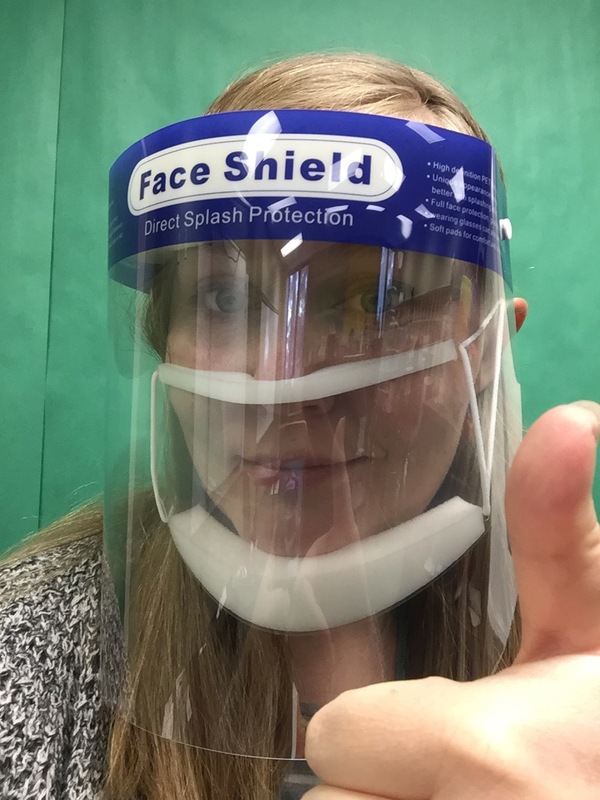 2020-03-15
2020-03-15Together and Apart
Flagstaff AZ. My husband was an occupational therapist who regularly worked in the ICU at Flagstaff Medical Center. I remember the week after the lockdown started (March 15th or so) the Covid-19 numbers were doubling every week at FMC. My husband started changing out of his scrubs and shoes in the garage. I was a speech therapist with the school district and we were all asked to stay home, which was good because I have two school-aged children. As the Covid numbers started to skyrocket in our region due to a devastating outbreak on the Navajo nation, my husband became more and more worried about bringing the virus home since there was a shortage of PPE. When it was announced that my own job would go remote and I would need to start scheduling teletherapy sessions with my students, we decided it would be better for me and the kids to go live with my mom and dad in Tempe for a few weeks. My mom is a retired teacher and offered to teach my kids while I worked with my students online. The kids loved having grandma be their teacher. I had to learn how to work with preschoolers with disabilities over Zoom, which is no easy task! Meanwhile, my husband was providing us updates; when he finally got fitted for a tyvek suit was a happy day because he could spend all day in it helping patients. The doctors were trying new therapies with patients every week, but mostly he saw many people seem to get better and then take unexpected deadly turns. Treating isolated, scared patients while feeling helpless to know what to do was taking a toll on everyone at the hospital. The kids and I spent 7 weeks with my mom, face-timing him every night. Finally, as the school-year came to a close, we were able to reunite. I captured the moment we got home and my husband hugged my 5 year old son. We were so lucky; no one in the family had gotten sick so far despite my husband being in close proximity to patients each day. Over the summer and into the next school year we were hoping for some normalcy to return but it was nothing but adapting to change. The kids made friends with the neighbors down the street not by playing in the front yard, but by yelling greetings over the fence. When they started school in the fall we organized a "pod" with other families whose children were in the same classes as ours at DeMiguel elementary. We had four kindergarteners and three 2nd graders all doing school over Zoom at the same time, which was not easy for the parents who had to oversee them (my husband had the honor at least once a week), but the kids really benefitted from having friends to play with during breaks. We saw them become more motivated to participate and happier overall. I started seeing some students in-person for the first time at the school on a very limited basis. I wore clear PPE products so my students could see my mouth. The kids didn't go back to in-person school until about a year after the lockdown (Spring 2021). As the school year ended, the wildest school year of our lives, things did start to seem normal again, but we ended up leaving Flagstaff for Tucson due to soaring high home prices and my husband needing a fresh start away from the memories of the early pandemic. -
 2022-05-01
2022-05-01Disposable mask on soccer field, urb 15 de enero
After a game of soccer, that ended when the ball was kicked out of bounds and landed on cactus (rendering the ball flat), I took this picture of a disposable mask left behind on the soccer field. -
 2022-05-01
2022-05-01Mask trash soccer field in Parque de la Independencia
This is a mask left behind on a cement soccer field in Parque de la Independencia, Urbanización 15 de enero in Arequipa, Peru. -
 2022-05-01
2022-05-01Mask trash parque de la independencia
Mask trash on the football field at parque de la Independencia urb. 15 de enero -
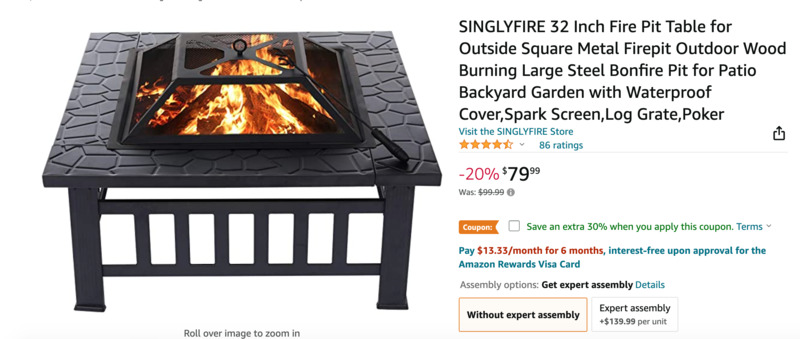 2020-04-03
2020-04-03My Neighbors and I
My neighbors and I have known each other for multiple years, and are good friends. They came from India as immigrants back in 2000 and started a family, eventually moving in right next to us about two years before the pandemic. Once COVID hit, our usual Saturday night bonfires together came to a halt as we wanted to be safe and not spread the potential infection. Instead, they bought an entire fire pit off Amazon, and through the trees each Saturday night we continued our Saturday night bonfires together, just not next to each other. This was honestly a beautiful experience because no matter what we found a way to continue to connect with each other in a safe and timely manner! We still keep in contact to this day and reminisce on our old memories as neighbors. -
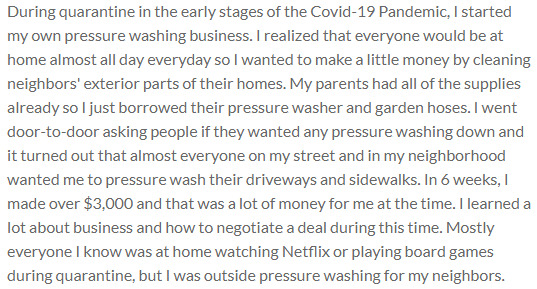 2020-04-05
2020-04-05How I started a business during quarantine in 2020
During quarantine in the early stages of the Covid-19 Pandemic, I started my own pressure washing business. I realized that everyone would be at home almost all day everyday so I wanted to make a little money by cleaning neighbors' exterior parts of their homes. My parents had all of the supplies already so I just borrowed their pressure washer and garden hoses. I went door-to-door asking people if they wanted any pressure washing down and it turned out that almost everyone on my street and in my neighborhood wanted me to pressure wash their driveways and sidewalks. In 6 weeks, I made over $3,000 and that was a lot of money for me at the time. I learned a lot about business and how to negotiate a deal during this time. Mostly everyone I know was at home watching Netflix or playing board games during quarantine, but I was outside pressure washing for my neighbors. -
 2022-03-30
2022-03-30Vaccination clinic in Callao
This Instagram posts shows that today, all day (8-5) people in Callao can head to the Centro de Salud Quendo to receive the COVID vaccine dose that they need. Children 5-11 can get their first or second dose and children 12-17 can get their 3rd dose 5 months after the second dose, and those over 18 can get their 3rd dose 3 months after the second one. The photo show s a bus that is carrying healthcare workers to the destination to help vaccinate the people there. -
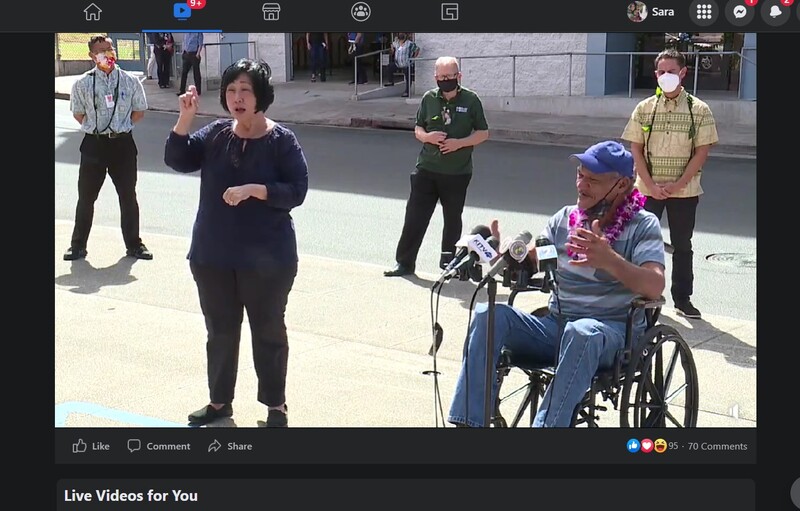 2020-11-17
2020-11-17Punawai Rest Stop For Homelessness
KHON2 News Story on the Punawai Facility. The facility aims to help the community combat homelessness and aid those experiencing homelessness bringing hope to everyone. -
 2021-01-30
2021-01-30A View from My Window
During a difficult time in which we are separated from one another, it is important to make the most out of every small moment. We don't notice all the tiny things that pass us by each day. This is my view. -
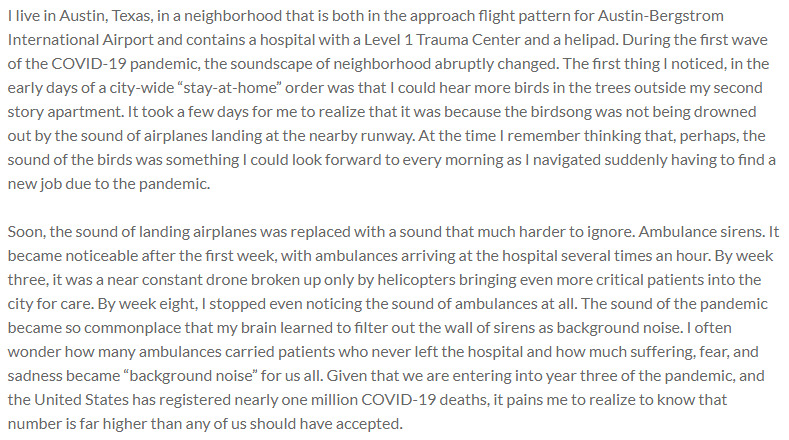 2020-04-15
2020-04-15An Unacceptable Wall of Sound
I live in Austin, Texas, in a neighborhood that is both in the approach flight pattern for Austin-Bergstrom International Airport and contains a hospital with a Level 1 Trauma Center and a helipad. During the first wave of the COVID-19 pandemic, the soundscape of neighborhood abruptly changed. The first thing I noticed, in the early days of a city-wide “stay-at-home” order was that I could hear more birds in the trees outside my second story apartment. It took a few days for me to realize that it was because the birdsong was not being drowned out by the sound of airplanes landing at the nearby runway. At the time I remember thinking that, perhaps, the sound of the birds was something I could look forward to every morning as I navigated suddenly having to find a new job due to the pandemic. Soon, the sound of landing airplanes was replaced with a sound that much harder to ignore. Ambulance sirens. It became noticeable after the first week, with ambulances arriving at the hospital several times an hour. By week three, it was a near constant drone broken up only by helicopters bringing even more critical patients into the city for care. By week eight, I stopped even noticing the sound of ambulances at all. The sound of the pandemic became so commonplace that my brain learned to filter out the wall of sirens as background noise. I often wonder how many ambulances carried patients who never left the hospital and how much suffering, fear, and sadness became “background noise” for us all. Given that we are entering into year three of the pandemic, and the United States has registered nearly one million COVID-19 deaths, it pains me to realize to know that number is far higher than any of us should have accepted. -
 04/29/2021
04/29/2021Jacob Wrasse Oral History, 2021/04/29
Jacob Wrasse was born in Durand, Wisconsin and is an alumni of the University of Wisconsin-Eau Claire, where he was on the Forensics team and was elected Student Body President. He currently works in the Chancellor’s office at UWEC as the Legislative and Community Relations Liaison. In his interview, Jacob Wrasse talks about the effects of the Covid-19 pandemic on his work, family, and the greater Eau Claire community. He gives insight into the effects of going through the pandemic in the winter where there were limited outdoor opportunities and working from home as a community relations liaison -
 02/22/2021
02/22/2021Bryan Gilbert Oral HIstory, 2020/10/05
HIndiana University – Purdue University Indianapolis student Shanda Nicole Gladden interviews Bryan Gilbert for the COVID 19 project in hopes of collecting stories about racial justice movements in the context of COVID 19. In this interview they discuss noticeable changes in his neighborhood and work place. The reputation of the Eastside of Indianapolis and personal concerns surrounding COVID. The interviewee spoke about his personal concerns surrounding COVID as well as politics, the importance of voting and rising racial tensions. They spoke about the Black Lives Matter movements, protests and demonstrations and art installations that have followed that. They also spoke about hopes for the future, predictions on how COVID will impact the future. How COVID might change relationships (family, friends, community and society as a whole). The interviewee also touched topics of the LGBT+ community, getting married during a pandemic and the hopes he has for the progression of the community in the future. -
 2021-08-28
2021-08-28End of pitching in
At the beginning it was different. April and May of 2020 was not the later, divisive and hate-filled environment that would allow the Covid virus to flourish, not the largely “every-man-for-himself” climate whose popularity grew to mirror the surge of the pandemic itself. Back then, everyone was hunkering down, the streets were empty, and Santa Monica was more like the city I had seen in pictures from the 1940's. The light even seemed different. Despite the specter of certain death, or at least alongside it, was an almost relaxed feeling: we were all in this together, against a common (if mysteriously deadly) enemy, and there is nothing we could do. Well, except stay indoors, and avoid contact with other humans at all costs. I know that during WWII, Santa Monica hummed with activity, with defense plants working three shifts, and Clover Field roaring with warbird take offs and landings almost continuously, and in the Spring of 2020, Santa Monica was still largely of the “we did it once, we'll do it again” mindset—everyone had a job to do, and it was actually an easy one: all you had to do was to keep to yourself. Loose lips may not sink ships anymore, but uncovered ones (especially in public) could spew a deadly toxin—the origins and makeup of it almost completely unknown—and leave devastation in its wake. This feeling couldn't, and wouldn't, last long; humans being what they are. With a national figurehead in a leadership position that was unable to understand complexities, and that largely and specifically promoted failure, the home front grew distrustful of the concept of a “common good”. Citizens quickly grew weary of making sacrifices, of doing without the niceties to which they had become accustomed. Under the guise of individual freedoms, all suffered. “It will all just go away very soon”, we were told, and eventually it did. Not the disease. Our American way of life. -
 2020-05-06
2020-05-06Facilities in buildings stopped because of covid
This shows how facilities in buildings that we took for granted were taken away because of the risk of covid -
 2020-04-12
2020-04-12The Empty Streets of Time Square
“A pedestrian crosses a nearly empty street in Times Square, New York's most-visited tourist attraction, on Wednesday, April 1.” The bright lights and advertisements bordering the streets have no people or tourists to hypnotise and blind. The usual busy streets of New York are almost completely vacant. I personally felt like the world was literally ending. There was no aggressive honking from impatient drivers, no yelling from pointless arguments on the street. Only the sparse pedestrians, the singular car, but nothing else. Everything was closed. -
2020-04
Empty New York
This is a photo I took of an empty street in New York. During the first peek of the pandemic, New York traffic-filled streets and bustling attractions were rather empty. -
 2020-05-02
2020-05-02Empty NYC
The once bustling and lively city of New York, thanks to Covid-19, transformed into a deserted and helpless concrete island. I captured this photo in May of 2020, a depressing time for so many in our city, country, and world. If I had taken an identical photo in the same spot at the same time 3 months before, I would have quite frankly been run over. The concept of one of the most crowded compact cities being abandoned was unthinkable as well as symbolic to the unimaginable and tragic things this pandemic has brought. -
 2021-05-31
2021-05-31Empty Dusk of 6th Ave
The streets were different than usual, it was the ironic sense of peacefulness arising from emptiness. -
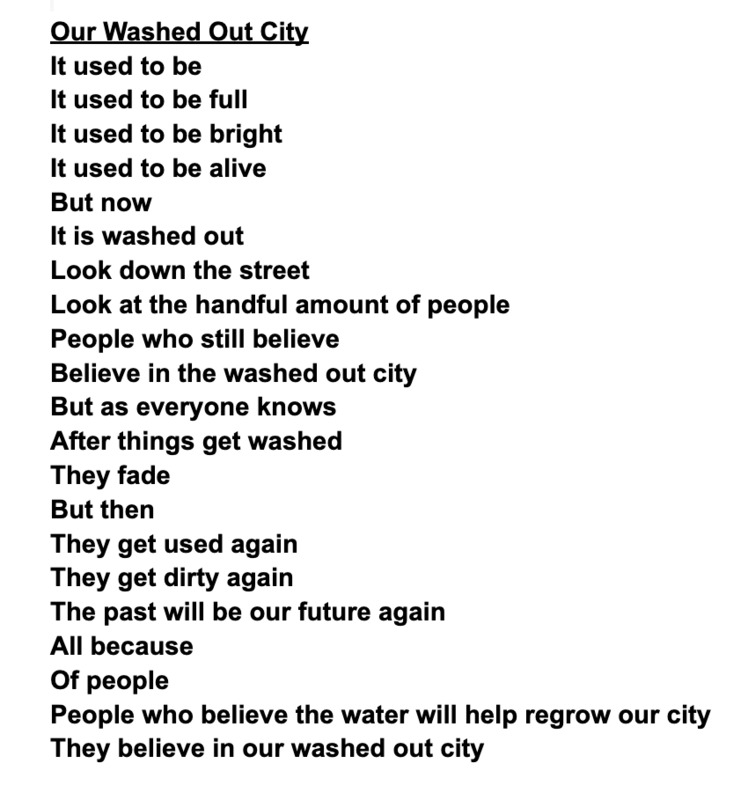 2021-12-16
2021-12-16Our Washed Out City
This is a photo of my poem that I wrote during the beginning of COVID at school. It memorializes NYC and how it was so empty like it was washed out. -
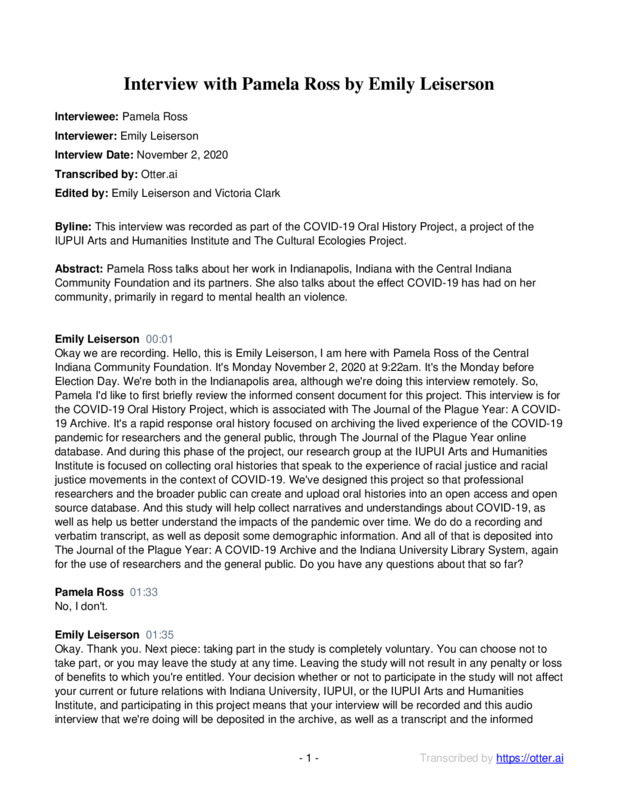 11/02/2020
11/02/2020Pamela Ross Oral History, 2020/11/02
This interview was recorded as part of the COVID-19 Oral History Project, a project of the IUPUI Arts and Humanities Institute and The Cultural Ecologies Project. -
 03/19/2021
03/19/2021Jeff Litsey Oral History, 2021/03/19
Jeff Litsey is a resident of the Fountain Square Neighborhood in Indianapolis with his wife and two children. Jeff discusses how the pandemic has affected his family life and schedule while also discussing how the neighborhood dynamics have evolved during the pandemic. Jeff talks about the challenges of running a small, locally owned, coffee shop during the pandemic in the Fletcher Place neighborhood of Indianapolis. This includes revenue, business plan evolution, government assistance, adjusting employee’s hours and pay, and helping employees and customers feel safe during the pandemic. He also illustrates how the neighborhood community helped his employees through tips that rolled into a community employee assistance plan. Additionally, Jeff discusses his anxiety that increased during the pandemic from running a business and worrying about how his shop could affect others and himself. This extended to worrying about his family. He discusses how the hobbies of art, hiking, and birdwatching helped him feel better. The interview ends with his hopes for all people to have healthcare and a home. -
 2021-10-18
2021-10-18Looking Back to Look Forward and Adapting to Overcome
This screenshot shows an Instagram post from St. Mary's University. The screenshot is in regards to the University's annual marathon for the neighborhood, depicting an in-person event with evidence of masks and other restrictions/changes due to COVID-19. Seeing as the event is back to being held in person, it has both clear similarities and clear differences in respect to the years before, further proving the fact that the pandemic is ongoing and continued adaptation is necessary before we will be able to overcome. -
 2020-10-15
2020-10-15Looking Back to Look Forward and Adapting to Overcome
This screenshot shows an Instagram post from St. Mary's University. The screenshot is in regards to the University's annual marathon for the neighborhood, announcing a virtual marathon this year, that participants can do from anywhere. This is different from the years past, as well as from the years to come, further proving the fact that the pandemic is ongoing and continued adaptation is necessary before we will be able to overcome. -
 2019-10-06
2019-10-06Looking Back to Look Forward and Adapting to Overcome
This screenshot shows an Instagram post from St. Mary's University. The screenshot is in regards to the University's annual marathon for the neighborhood, announcing a virtual awards ceremony. Seeing as this event is clearly being held in-person, with little social distancing and no evidence of masks, it is different from the years before, further proving the fact that the pandemic is ongoing and continued adaptation is necessary before we will be able to overcome. -
 2021-09-10
2021-09-10HIST30060 Group-chat shenanigans
Lockdown shifted the nature of community dynamics in our local area. We live in a peri-urban region on the outskirts of the Yarra Ranges; as such, neighbouring properties are separated by large swathes of Australian bush. This can be isolating at times; it’s very different to suburban living. Our street (which spans about 7kms) and adjacent streets have a WhatsApp group chat named ‘Fireguard’, which allows residents to share information about fire safety, planned burn-offs and emergency warnings. However, during lockdown the chat was increasingly used for the purposes of socialisation. Suddenly, distant neighbours began sharing jokes and engaging in conversations about lockdown living, through the chat. The chat became a site of social interaction that the members of our area probably didn’t realise they needed, until they did. We eventually decided to create a separate chat for general/social purposes only, the title ‘WHICHBIN’ constituting a friendly inside joke about one particular chat member who never fails to ask, “which bin?” she needs to put out for collection each week. -
 2020-03-27
2020-03-27Walking Through Covid-19
During the height of the pandemic and quarantine, my family and I spent hours a day walking. We would walk through our neighborhood, the Metroparks, and we would find new trails and paths. One day they made an announcement that the country would be in quarantine for another month. my family and I were concerned and didn’t know what to expect. We were thinking how much longer can this be, what is our world coming to, and will everyone stay safe. we were unsure of our future. we decided to take a walk to clear our minds. During the walk, we came up to sidewalk chalk that said be positive with handprints, hearts, and other creative designs. It was a young girl who was designing these patterns and quotes and it made us realize that we need to stay positive during these tough times. It was a day we all remember during quarantine. -
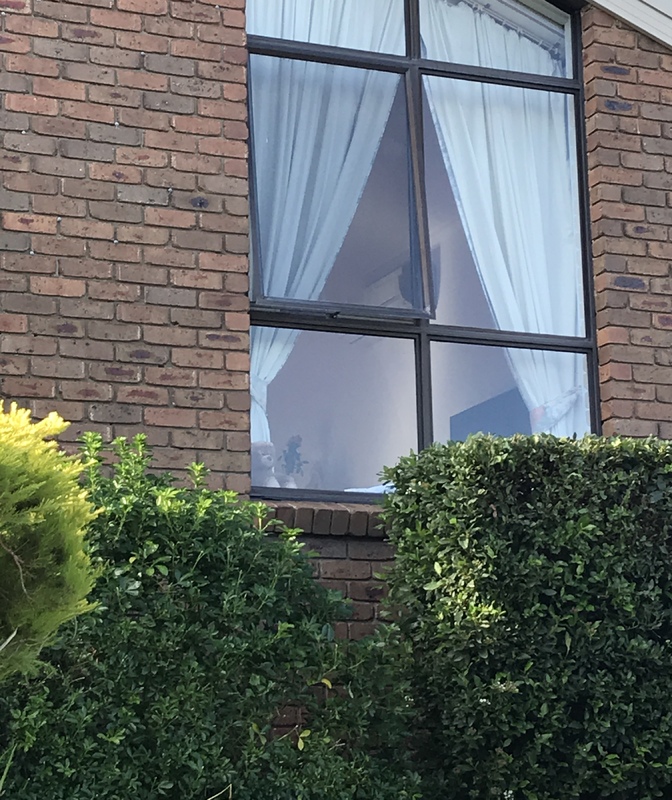 2020-04-13
2020-04-13HIST30060 - Easter Hunt: Bears Hiding in Windows
These two photographs were taken in April 2020 during Easter. My neighbourhood decided to come together and do something special for the kids - many families participated and placed teddy bears on their windows facing the footpath. This created a 'Bear Hunt' trail for children and their families to participate in. I decided to take a walk around my neighbourhood to experience this for myself and it has become one of my most memorable moments during the COVID-19 lockdown. Many children and their families were walking around socially distanced, and strangers I had never seen before would wave at me across the streets and exchange greetings. The sense of community was really strong and it felt like everyone was together, in solidarity, even amidst the toughest of times. -
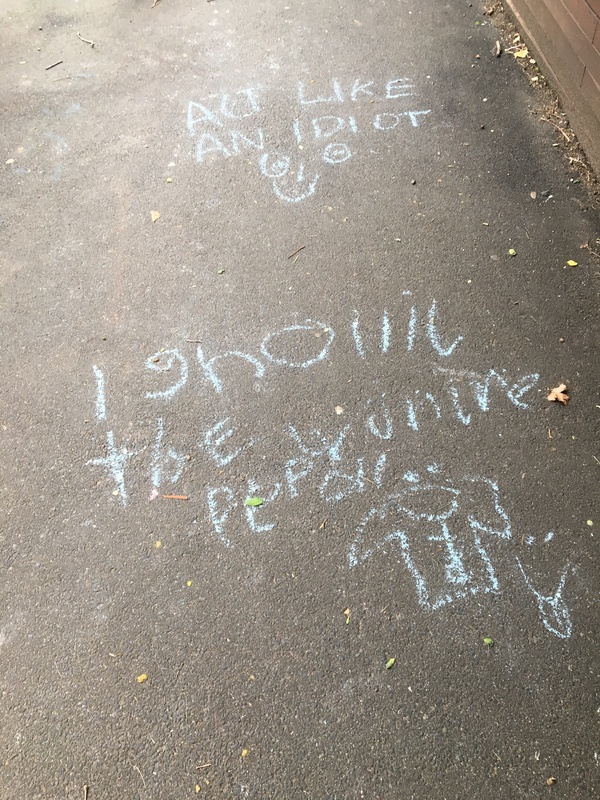 2020-04-12
2020-04-12Joy on the Pavement
During Melbourne’s first lockdown in 2020, movements to bring joy to the few remaining active public spaces were organised over social media and among local communities. One trend was pavement art that encouraged the walker to “laugh”, “pick up some rubbish” and “strike a pose” on their permitted hour of exercise. These minor artworks expressed an optimism in community strength at the early stages of the pandemic; they expressed, too, a resilience in Melbourne’s identity as a city of art and culture. By the second lockdown in August 2020 the chalk had been washed away and there was little to replace it. Creating community from inside our own homes, it turned out, was much harder to sustain than anyone had imagined. Submitted for University of Melbourne HIST30060, Semester 2 2021. -
 2021-07-06
2021-07-06HIST30060: NO BASKETBALL FOR ALL!
The local basketball courts near my house were closed due to risk of contamination with COVID-19, much to the dismay of my sweet young neighbours. -
 2021-07-24T14:50
2021-07-24T14:50Chicken feeding as a lockdown activity 2021
In July 2021, while on one of my afternoon walks, I discovered this local lockdown activity of chicken feeding. A local household was offering people the chance to feed their very friendly and excitable chickens. I am unsure when this activity first started as I do not usually walk the way that would take me past them. However, it was an amusing and relaxing thing to be able to do amidst the chaos of a global pandemic. The chickens were really very cute, despite not the brightest creatures I've ever known. I have visited them with my family regularly ever since that first time and have noted that other people, often local children, have also relished the opportunity to interact with live animals. In a small way, I believe the chickens have brought the neighbourhood a little closer together and given local children the opportunity to interact with animals they would not normally get a chance to. Sadly, due to old age and the presence of urban foxes the number of chickens has decreased and only one of the original trio remains (as of October 2021). However, she has a new friend now and is very keen to establish her authority. The sign and container of dry food has been removed but we often bring them other food- they are particularly fond of sowthistle. -
2020-04-11
(HIST30060) The 'Intimate Partner' Clause
For many experiencing the pandemic in Victoria, the intimate partner clause meant that our girlfriends, boyfriends, or partners were the only persons many young people were able to see - well at least legally that is. Initially, the intimate partner clause did not exist, which was heartbreaking for many couples that lived apart, facing the prospect of not seeing their partner for an unknown amount time, during an unsettling and unprecedented period. When the clause was introduced, it was a saving grace for couples. For others, it legally introduced a sneaky way to meet people inside their bubble, particularly after connecting online. I was lucky enough to meet my girlfriend during what was her first and my last on-campus class for the last two years - before lockdown was a thing. After facing the scary prospect of not seeing each other during the first stages of Melbourne's first lockdown, the intimate partner clause allowed us to spend every day for months and months between houses, happily isolating in our shared bubble and growing incredibly close. -
 2020-03-15
2020-03-15Empower: Ecuador - Canceled (Personal Experience)
I was part of the group of student that was preparing themselves emotionally, spiritually, and physically to go to Ecuador and be present with a community in Guayaquil. During this class and for the entire semester we were in retreats together, reading, journaling, and sharing our hearts with each other. We built a community and were deeply connected with the mission of the program and the desire to go to Ecuador and meet the neighbors. However, exactly a couple of days before traveling the lockdown happened, and the plans were canceled. We did not know that the world was going to change so suddenly and immediately. I clearly remember the meeting we had to announce that the trip was canceled and how most of us were filled with sadness and crying. Afterward, we kept being in connection to Ecuador with our prayers and writings. We even wrote some letters to our neighbors in Ecuador. So, this story is to reflects how we can be in connection and engagement with others even during times of depression and distance and how in specific this program had to adapt through COVID-19. To express the story I chose the screenshot of an Instagram post from the Community Engagement Office at St. Mary's University. -
2020-03-21
Gardening During the Apocalypse
I can't think of the beginning of the COVID-19 pandemic, the shut downs and lock-ins, the stay-at-home orders without thinking of my brief foray into gardening. My husband and I bought our house in northwest Baltimore in April 2019. Our little duplex sits near the end of an unbelievably picturesque street in a fairly affluent neighborhood known for its garden communities and HOA-hosted wine and cheese parties you have to pay to attend. The neighborhood is surrounded by much poorer neighborhoods and heavily-trafficked streets, the direct product of red-lining in Old Baltimore. While the Original Northwood neighborhood is much more diverse - demographically and economically - than it was when it was first established in the 1930s and 1940s, my husband and I, as some of the only residents under 40, still felt like we didn't necessarily fit in with our older, more well-to-do neighbors, despite absolutely adoring our little home, which had been lovingly renovated and reimagined by its previous tenants. Come March 2020, however, the noise from the crowded streets, the surrounding neighborhoods, and from our own neighborhood, died down substantially. Our streets and its surrounds have always been a great place to go for a walk, but now every day people were strolling by in ones and twos, sometimes in small family units. Everyone needed to get out of the houses they were now cooped up in, and I was no exception. Much to my mother's chagrin - and likely to my neighbors' embarrassment - I did not inherent my mother's green thumb. Because I am a millennial I found an app that identifies plants and set about rooting out weeds, pruning the flowers the previous tenants had not intended for me to neglect, picking up the endless stream of leaves from our several 100+ year old trees, digging up more weeds and debating with my husband about whether we should start an herb and vegetable garden or put in a patio in the little garden area that connects our front and back yards. I did not become proficient at gardening. I am much better than I was, however, at identifying the truly astonishing diversity of plants in my own garden and in my neighborhood by scent and even touch. I learned that the dried and withered allium stalks pull effortlessly out of the ground after they die, that African violets also give way to a gentle scooping from the earth, and that thistle, of course, will still try to prick you as it attempts to cling to the soil. I learned that those thin but tough shoots of elm and oak born from the seeds and acorns the squirrels missed not only grow rapidly, but are extraordinarily difficult to rip from the earth. And no matter how much seemingly-delicate clover one claws at, its roots will always remain beneath the surface, as virulent in a day or two as when one earlier tore at it in complete dismay of its sheer stubbornness. I did not become proficient at gardening. But I did relish the feeling of cool, damp earth underneath my hands, even in my fingernails, the crunch of dry leaves, the slick sliding of wet leaves, the red, angry weals left on my hands from those stubborn oaks. I felt accomplished as I pulled lovely, but ultimately threatening African violets and wild raspberry from underneath the spreading cover of the hostas, and as I pulled wild mint, lemon, and rosemary for tea and cooking. I told myself I'd use the ramps (a species of wild onion that smells and tastes sort of of like a combination between garlic and scallions) in a soup, as a college roommate of mine had done, but I forgot to harvest them in time. From what I recall, summertime is best, particularly late summertime. The other thing I remember about this time spent in my garden, hands in the dirt, sweat on my brow, bug bites inflaming every available inch of skin, is the new sense of connection I felt with my neighbors who stopped to wave hello, nod and smile at my gardening efforts. Neighbors who I hadn't gotten to know before the pandemic which now prevented us, due to fear of contamination from contact with other people, from truly getting to know each other still. But somehow, the simple act of being out in my garden, doing this simple, repetitive toil, made me feel like I was participating in a ritual, an activity that linked me to the less unsavory past of the community, and to neighbors who otherwise might have remained alien in a plague environment that seemed to bring a new apocalypse with every week.
